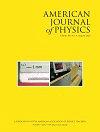Electric field lines of an arbitrarily moving charged particle
IF 0.9
4区 教育学
Q3 EDUCATION, SCIENTIFIC DISCIPLINES
引用次数: 0
Abstract
Electromagnetic fields of relativistic charged particles have a broad frequency spectrum and a sophisticated spatial structure. Field lines offer a visual representation of this spatial structure. In this article, we derive a general set of equations for the field lines of any moving charged particle. The electric field lines are completely determined by the unit vector from the retarding point to the observation point. After proper transformations, the field line equations describe the rotation of this vector with an angular velocity coinciding with Thomas precession. In some cases, including all planar trajectories, the field line equations reduce to linear differential equations with constant coefficients. We present a detailed derivation of these equations and their general analytical solution. We then illustrate this method by constructing field lines for the “figure eight” motion of an electric charge moving under the influence of a plane wave, including complex field lines in three dimensions.任意移动的带电粒子的电场线
相对论性带电粒子的电磁场具有宽广的频谱和复杂的空间结构。场线提供了这种空间结构的视觉表现。在本文中,我们导出了任何运动带电粒子的场线的一般方程组。电场线完全由缓速点到观测点的单位矢量决定。经过适当的变换,场线方程描述了这个矢量的旋转,其角速度与托马斯进动一致。在某些情况下,包括所有平面轨迹,场线方程可简化为常系数线性微分方程。我们给出了这些方程的详细推导和一般解析解。然后,我们通过构建在平面波影响下移动的电荷的“数字8”运动的场线来说明这种方法,包括三维的复杂场线。
本文章由计算机程序翻译,如有差异,请以英文原文为准。
求助全文
约1分钟内获得全文
求助全文
来源期刊

American Journal of Physics
物理-物理:综合
CiteScore
1.80
自引率
11.10%
发文量
146
审稿时长
3 months
期刊介绍:
The mission of the American Journal of Physics (AJP) is to publish articles on the educational and cultural aspects of physics that are useful, interesting, and accessible to a diverse audience of physics students, educators, and researchers. Our audience generally reads outside their specialties to broaden their understanding of physics and to expand and enhance their pedagogical toolkits at the undergraduate and graduate levels.
 求助内容:
求助内容: 应助结果提醒方式:
应助结果提醒方式:


